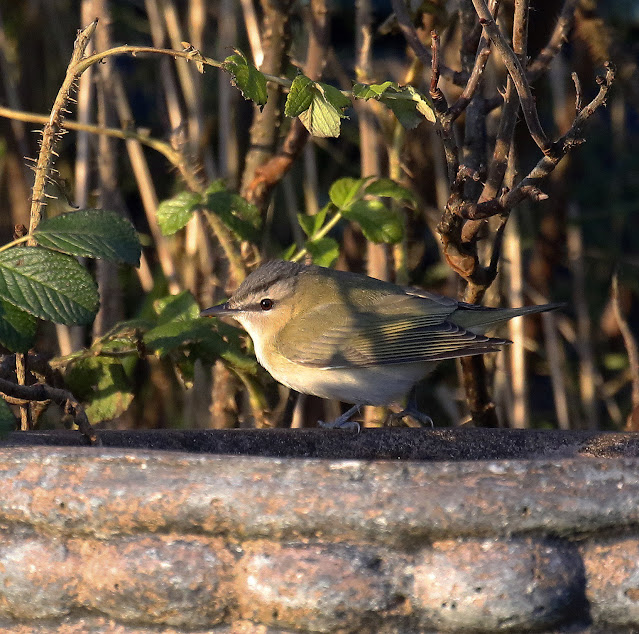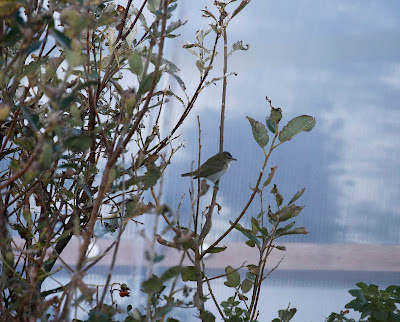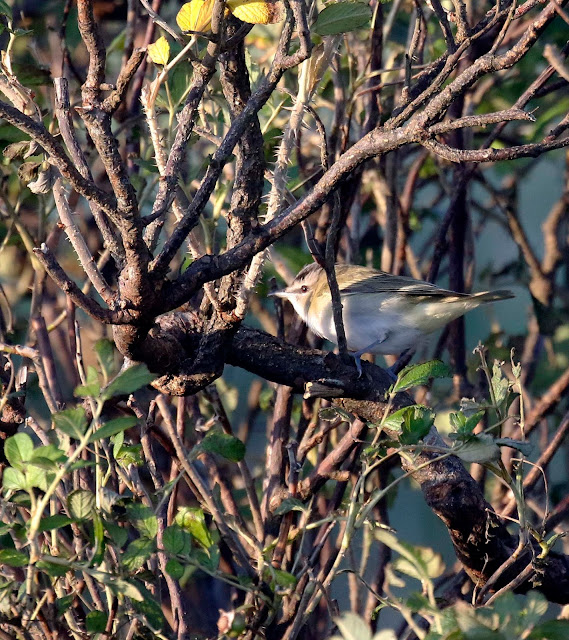Today started unremarkably At least there was no rain although the wind remained strong but thankfully nowhere near as forceful as yesterday when, in exposed places, it reached 40-50mph.
We visited a small quarry just north of Lerwick, right by the main road and where a Red breasted Flycatcher led us a merry dance, refusing to show itself well and kept to the back of a large willow. Realising we were not going to get any better views we decided to try our luck at a place called Aith where a juvenile Woodchat Shrike had been frequenting gardens, adjacent to some moorland, for the past few days.
The strong wind could not be helped but it would probably mean that the shrike would be keeping low and in cover and this presumption proved entirely correct. Stationing ourselves on a rough grass strip at the back of the gardens, we soon found the shrike feeding from low branches but on the far side of the bushes, out of the wind, and therefore only partially visible.
 |
| Juvenile Woodchat Shrike |
About to leave Aith and sat in the car deciding where to go, a fellow birder came running across to us with news that a Red eyed Vireo, a very rare vagrant from North America, had been re-found in the Community Woodland at Brae. It had been reported two days earlier but not publicised due to the wood being right next to a school. Concerns had been raised not by the school but by the birders who had found the vireo, worried that their intentions with cameras and expensive optics near to children would be misinterpreted. Such is the world we now live in.
Apparently these concerns were no longer considered applicable this morning and we knew that this would mean a good majority of the birders on Shetland would be heading for Brae to try and catch a glimpse of this very rare transatlantic vagrant, of which less than 160 have been recorded in Britain. Its status on Shetland is even rarer than on mainland Britain with the first only being recorded in 2012, and this one was only the fourth to be recorded on Shetland, so everyone was naturally keen to get it on their list.
A very scenic drive along deserted roads, the surfaces perfect courtesy of the EC and Shetland Islands Council grants, brought us to the large village of Brae and my heart sank at the sight of swarms of birders milling around outside and inside the wood.There must have been well in excess of a hundred and fifty birders, all hoping to catch sight of a small, very active bird in the constantly moving, wind disturbed leaves of the close packed trees. It was nigh on an impossible task but still birders tried, some wandering about while others stood in groups hoping to detect some movement other than from the leaves.The only realistic hope of seeing the vireo would be when it flew from one part of the wood to the other which apparently it was doing on a regular basis.The views though, would hardly be spectacular or prolonged.
Each time some lucky birder caught a glimpse of the elusive vireo and alerted others there would be a surge in the crowd and a moving tide of mainly green and khaki would flow through and around the wood, gravitating towards the hallowed location but it was always too late by the time everyone got there. So once more all would stand about awaiting the next sighting and when it came there would be another determined rush to the location.
For an hour I was part of the throng, wandering aimlessly from one end of the wood to the other and when someone was fortunate enough to catch a glimpse of the vireo, follow everyone else as they gravitated to the spot but I was always too late
I began to tire of the crowds and stood back for a while to apply some thought to my situation.It was obvious the bird was moving through the wood from end to end on an irregular basis and one just had to be lucky enough to be in the right place at the right time to see it. Chasing after it was not working so it seemed logical to stand still in a suitable spot and hope it would come to me on one of its forays.
I decided to walk to the far end of the wood and stand there, quietly, on my own on the track that winds through the edge of the wood and wait to see if the vireo would appear in the trees around me. It had been seen here earlier so I was in with, admittedly, a slim chance of success.
Half an hour later and with no sign of any bird at all I was losing faith in my decision but then a small group of birders hurriedly approached on the track and told me the vireo had been seen to fly in my direction. A minute or two later and a bird, possibly the bird flew behind us and disappeared into some pines.I walked around a bend in the track to hopefully get in front of the bird and it worked like a charm. A dark shape, no more than a silhouette in the branches, moved into the open and perched for thirty or so seconds on a bare twig at the top of a small sycamore. It was unmistakeable. It was the Red eyed Vireo, facing me head on, its greyish white breast illuminated in the sunshine and its grey crown, black and white eye striped face and dull green upperparts clearly visible. I raised the camera to record my moment of triumph but just as I did it flew. Never mind I had seen it and very well. A minute later the main crowd surged around the corner.Too late!
Others spent all day in various parts of the wood and failed to get a glimpse of the bird so I was very lucky.
I went and found Mark and Les stationed inside another part of the wood and they had also seen the vireo, so all was well and we decided to leave the crowd and move on to Wester Quarff where there was a chance of seeing both a Little Bunting and a Bluethroat.
It did not quite work out as we planned as there was no sign of either when we got there but another birder suggested we take the upper road to some disused farm buildings as there was a good chance of seeing a Red backed Shrike and a Barred Warbler, both showing well, according to other birders we met on the road as they came back from the farm.
A short walk along the road brought us to the edge of the farm buildings and a birder pointed out the shrike, perched on the metal spikes of a farm implement. It was a juvenile, its warm reddish brown plumage in marked contrast to the Woodchat Shrike we had seen earlier.It appeared confiding so we walked into the derelict farmyard and approached it from there, with the pleasing realisation that the shrike would allow us to come close without being alarmed.
It was in fact ridiculously confiding and allowed me to get within yards of it and I took full advantage.Two shrike species in one day is surely something to remark upon, especially in Britain.
 |
| Juvenile Red backed Shrike |
The Barred Warbler proved more elusive but evenually showed itself in a hedge bordering the property of a lady who, unusually for Shetland was not well disposed to birders and made a ridiculous fuss even though we were on a public road and told us not to look over her garden. Fortunately the warbler flew across the road and we could look at it without giving her an excuse to berate us further. The warbler continued proving elusive but occasionally gave good, albeit brief views
Walking back to the car I found Mark had been given some rather startling information concerning another Red eyed Vireo that had been found at a place called Sandwick. Apparently this individual was showing very well, so well that the birder Mark had spoken too had seen it down to just a few feet! This was too good to resist but time was running out and if we did not hurry dusk would be upon us.
It was not too far to Sandwick and we found a space in a line of birder's cars parked on the roadside verge and walked to the site which was up a small dead end road. The birder we met at Wester Quarff had told us the vireo had been frequenting some stunted sycamores and rosa bushes in the front gardens of two adjacent houses, that fortunately this time belonged to birder friendly owners.
I followed a local birder into the adjacent back garden where a line of washing obscured my view, with the vireo popping into sight between an array of sheets, pillow cases, towels and various shirts hanging from the line. I found myself crammed into a corner by some bushes but for the moment could not see the vireo due to the full washing line but then, as if by magic, the vireo popped out just feet from me in full view and posed for a few seconds before flying up and over the bushes and out of sight. These were easily the best views I have ever had of a Red eyed Vireo.
Some of our fellow birders rushed off to see if they could find where it went after it left the garden but it was gone and this was the last anyone saw of it. The next day it was nowhere to be found.
Two Red eyed Vireos in one day on Shetland is unprecedented but unbelievably a third was also found on Shetland today but it too was gone the next day.
A day like this is surely why so many birders come to Shetland.


























No comments:
Post a Comment